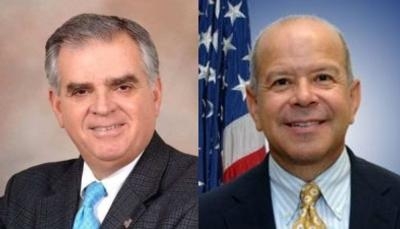Sat, Aug 25, 2012
Two Separate Grants For Runway Rehab, Air Quality Improvements
U.S. Transportation Secretary Ray LaHood on Thursday announced two grants for Washington state airports. Spokane International Airport will receive a $2.5 million grant to improve air quality by reducing the use of conventional fuels to power aircraft in the gate areas. Tacoma Narrows Airport will receive a $4.1 million grant to rehabilitate Runway 17/35.

The Secretary made the announcement today during a visit to Spokane, where he was joined by U.S. Sen. Maria Cantwell. “We are committed to helping airports around the country make infrastructure investments that will reduce fuel costs, protect the environment and enhance safety,” said U.S. Transportation Secretary Ray LaHood.
The FAA is awarding the grant to Spokane International through its Voluntary Airport Low Emission (VALE) program, which is designed to reduce all sources of airport ground emissions. Aircraft sitting at the gates currently use Auxiliary Power Units that burn jet fuel. The grant will enable the airport to install a land-side power unit and pre-conditioned air unit at each of the new aircraft gates that connect to a cleaner central heating and cooling system, saving fuel and reducing aircraft emissions on the ground.
Tacoma’s Runway 17/35 rehabilitation project will extend the useful life of the pavement and provide more traction for aircraft landing and taking off in wet weather conditions. “The FAA encourages airlines and airports to find constructive ways to reduce aviation’s impact on the environment and to make needed safety investments,” said Acting FAA Administrator Michael Huerta.
In fiscal year 2011, the FAA issued VALE grants for 12 low-emission projects at 11 airports. Since 2005, the FAA has funded 53 low-emission projects at 31 airports, which represents a total investment of $138 million in clean airport technology. That amount includes $109 million in federal grants and $29 million in local airport matching funds. Through VALE, airports are reducing ozone emissions by approximately 320 tons per year, which is equivalent to removing 17,600 cars and trucks off the road annually. VALE is funded through the Airport Improvement Program.
(Pictured L-R, Secretary LaHood, Acting Administrator Huerta)
More News
Also: 1st-Ever Space Crime Was a Fraud, IAE Buys Diamonds, Kennon Bows Out, Perseverance Rover An interesting moment came about this past Sunday as ANN CEO, Jim Campbell, noted tha>[...]
Have A Story That NEEDS To Be Featured On Aero-News? Here’s How To Submit A Story To Our Team Some of the greatest new stories ANN has ever covered have been submitted by our>[...]
From 2023 (YouTube Edition): Deviation from the Historical Mean Racine, Wisconsin-based DeltaHawk is a privately-held manufacturer of reciprocating engines for aircraft and hybrid >[...]
Smoke Began Entering The Cockpit During The Landing Flare, And Then The Pilot Noticed Flames On The Right Side Of The Airplane Analysis: The pilot reported that about 30 minutes in>[...]
Remote Communications Outlet (RCO) An unmanned communications facility remotely controlled by air traffic personnel. RCOs serve FSSs. Remote Transmitter/Receivers (RTR) serve termi>[...]
 Airborne 11.24.25: ANN's 30th!, Starships V3 Booster Boom, Earhart Records
Airborne 11.24.25: ANN's 30th!, Starships V3 Booster Boom, Earhart Records ANN FAQ: Submit a News Story!
ANN FAQ: Submit a News Story! Classic Aero-TV: DeltaHawk Aero Engine Defies Convention
Classic Aero-TV: DeltaHawk Aero Engine Defies Convention NTSB Final Report: Glasair GlaStar
NTSB Final Report: Glasair GlaStar ANN's Daily Aero-Term (11.22.25): Remote Communications Outlet (RCO)
ANN's Daily Aero-Term (11.22.25): Remote Communications Outlet (RCO)



